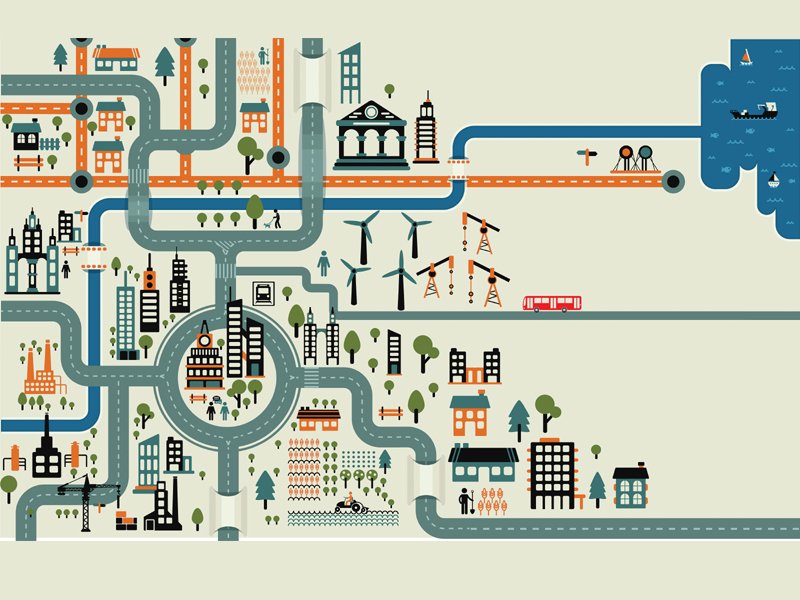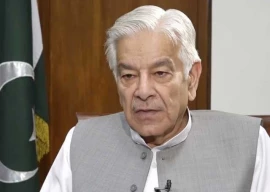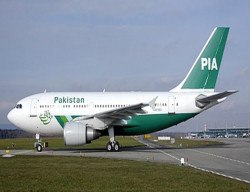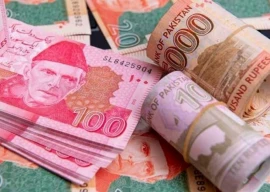
It is actually a reverent silence, the silence of the people of Lahore traveling in the brand new Metrobus. I experienced it on a late winter afternoon as I headed to meet a friend for coffee. Since I didn’t have a travel card, I got a token from the self-service ticket vending machine at the station, and walked down to the platform. I looked up at the LED information board — the next bus was arriving in one minute. A red bus pulled up. People queued. The bus docked, its doors opened simultaneously. Two women walked out, the rest of us shuffled in. The doors shut behind us. And then there was silence.
Shahbaz Sharif is a true Lahori, theatrical in his very essence. All his work is imbued by immense drama. He dreams up grand projects, and executes them at lightening speeds. By the time the opponents grasp the idea of his latest fancy and start protesting, the project is up and running. The Lahore Metrobus has been no exception.
Reactions to the Rs30 billion project, like any big-ticket number, have been polarised. Opponents have called it a wasteful political gimmick, a blot on Lahore’s beauty and insensitive to the city’s fabric and heritage. It has been oft-compared to the Berlin Wall for its ubiquitous iron bars. Opponents claim it has divided the city between the haves and have-nots and done little to relieve traffic congestion.
The Metrobus has also been termed an unjust expenditure, with the 27-km line costing more than allocation to any other sector (including education, health, water) under the Punjab Annual Development Programme 2012-13.

Barring self-praise from the provincial government, there are few vocal supporters. Most opinion leaders have avoided a dispassionate review that a project of this size and impact deserves. Which one is it? A case of political folly or far-sightedness?
Tyranny of geography
In sprawling cities, the tyranny of geography is unleashed on the most disadvantaged residents. In developing world cities such as Karachi and Lahore, for millions of working class citizens jobs and homes are set miles apart. Access to personal mobility — a motorcycle or car — is a distant dream. For them, a disproportionate part of the day, and a large share of their wage, is spent commuting to and from work.
Karachi, to state very generously, has a semblance of a ‘bus network.’ About 18,000 disheveled buses, coaches, wagons and mini-wagons ply hundreds of routes on an arbitrary number and naming scheme. For a city of 18m, that’s about one bus per 1,000 people. There is not a single map, however basic, that charts any part of the network, and navigating it, therefore, is a job for the seasoned, or the needy. No one ‘chooses’ this mode of transportation. Of course, strikes, shutdowns, celebrations and official holidays bring the entire network to a shuddering halt, leaving those who depend on it stranded.
Lahore, a city roughly half the population, never truly bothered with mass transit, until now. According to the Lahore Transport Company, there are 650 buses on 30 routes, with plans to add 2,000 new buses and realign the entire route network. That’s roughly one bus for over 3,700 people.

Rickshaws and taxis are increasingly unaffordable, even for the middle class. With CNG shortages and escalating fuel prices, the regular fares for a 10- to 15-km journey easily hits three figures. Most labourers and low-paid workers, therefore, use bicycles, and the bulk of the labour force opts for motorcycles. The rest, who can afford them, have cars.
The only answer, it seems, is to start thinking seriously about an efficient, dependable, and respectable mass transit system.
Why mass transit?
The conventional wisdom goes that as cities approach the one-million population mark, the administration needs to invest in a mass transit system — to move a large number of people back and forth. Unfortunately, that conventional wisdom eluded Pakistan’s city managers. They decided to restrict themselves to building roads, and let the private sector handle transport.
The love affair with asphalt — roads, expressways and flyovers — was ground in the belief that they would magically resolve congestion. The experience of South East Asian capitals — Bangkok, Jakarta and Manila — was lost on them. These cities built expressways upon roads upon expressways throughout the 1990s, only to realise that their cities were choked by the turn of the century. More asphalt led to more demand and in the absence of mass transit networks, it only worsened congestion and air quality. They went back to the drawing board, and drafted mass transit schemes.
Flashy trains?
The phrase mass transit conjures images of modern trains seamlessly transporting hundreds of thousands deep underground, or on elevated tracks. The former Punjab government, under Musharraf’s rule, claims it had a similar vision for Lahore. They have, however, possibly spent more on recent advertising bemoaning the scrapping of their vision by Shahbaz Sharif’s administration in favour of the Lahore Metrobus, than the planned system itself.
There is one small glitch: rail-based transit systems, elevated or underground, are stratospherically expensive. Subway lines, on average, cost between $100m to $250m per kilometre. The upcoming phase of Delhi Metro would cost $163m per km. Assuming that it would cost $150m per km, how much would the 27-km Lahore Metrobus have cost if it were rail-based? Rs405 billion.
So if we want to drastically transform our cities, and do it cheap and fast, the option we do have is the Bus Rapid Transit, or the poor man’s subway.
‘Surface subway’
Jamie Lerner, three-time mayor of Cuiritiba, in southern Brazil, came up with the idea of the ‘surface subway’ in early 1970s. A subway should have speed, reliability, comfort and good frequency. Lerner strived to have all these conditions on surface — hence the term ‘surface subway’ for the world’s first bus systems with dedicated corridors, off-board fare collection and the look and feel of a modern subway.
Today, 75% of Cuiritibans get to work by a bus in the morning, and 2.3m passengers use the BRT system every day. Other cities, including Bogota, Lima and Sao Paulo, replicated the BRT. The previously crime-riddled neighbourhoods, notorious for their drug cartels and high homicide rates, are now safer, more accessible. A large part of that success is attributed to BRTS.
Since 2000, 14 Chinese cities, including Beijing, Shanghai and Guangzhou, have built around 500km of BRTS. India is following suit, with five BRT systems, including Delhi, Ahmedabad, Jaipur and Pune, six under construction and eight in the pipeline. Jakarta has been implementing a massive system since 2004 by the name of TransJakarta. As of February 2013, TransJakarta has 12 corridors, totaling 172km, served by 520 buses that carried 310,000 passengers per day in 2011.
Pakistan’s debutante
Pakistan is a late entrant to the BRT club, with its first line opening in Lahore in February 2013. Within a few weeks though, it was carrying over 140,000 passengers a day.

The corridor, when viewed independently, is well designed, and meets criteria laid out by the New York-based Institute for Transportation and Development Policy. It has barrier-controlled, automated off-board fare collection, a service interval of less than 2 minutes in peak hours, a segregated right-of-way, modern stations with well-designed signage, information systems and a precision bus docking system synchronised with sliding, automated glass doors that give it the look and feel of a subway station. The stations allow you to park your bicycle as well, a facility that may appear wasteful now, but will come in handy later.
On the flip side, while the single corridor may not have rid Lahore of congestion and transformed lives instantaneously, it most certainly is the first solid brick in the foundation of a modern, efficient, dependable mass transit system. Karachi has in the meanwhile, hardly moved from the drawing board.
The Metrobus has its flaws. BRT corridors need to be part of a larger transit system with feeder services. It has also been designed ad hoc, independent of land-use patterns. Environmental feasibilities, a pre-requisite, were completed halfway through the construction. And, the unending stretch of iron bars does look ugly. Unfortunately, they are imperative to enforce the segregated right-of-way, and avoid accidents involving adventurous citizens crossing the passage. Once we all learn to be law-abiding, the iron bars could be replaced with low-rise kerb stones.
The Metrobus, therefore, has to be seen as such — a first experiment that would inform future urban mass transit in Pakistan. It has been expensive, but like all greenfield projects, it had to be built from scratch. A second line will would cost far less.
Opponents bemoan that the one-way fare, irrespective of distance, is Rs40. While that may be high for travelling between two or three stations, an auto-rickshaw, the only other alternative in Lahore in most cases, would cost far more.
Building on to the system
Don’t forget a BRT system helps with public backlash when fuel prices go up. Private buses may squeeze the passenger but in a BRT system the government can subsidise fares directly.
The BRT technology allows these policies to be swiftly implemented. Every trip on the Metrobus is recorded; therefore, for each trip made, the government could subsidise part of the fare.
The Metrobus should, therefore, be re-judged in light of its potential. Its cost should be weighed against the existing congestion and opportunity cost incurred in winding traffic jams across the cities. It is the cheapest, and extremely effective form of mass transit that has been built fast and to good standard. In a country as hungry for development as Pakistan, there could always be alternative ways of spending every rupee. But some projects are more urgent, and can have a greater multiplier effect, than others.
Better public transport is not wishful thinking, it is a right. Just like large parks and public spaces, mass transit systems democratise space and geography. And that is one of the more important prisms through which to judge the Metrobus on whether it is an expensive mistake or a judicious investment.
Karachi: the past, present and future of public transportation
Karachi has been unfortunate. It is consistently relegated to the bottom of quality-of-living indices. The Economist Intelligence Unit called it the 6th worst city to live in. This notoriety has stuck largely because it is the only city its size (18m) without a mass transit system.
This was not always the case, though as early investment proves. The first steam tramway was conceived as early as 1881, when the city’s population was around 75,000. It started working in 1885 in Old Town and Saddar. By its 70th anniversary in 1955, there were 64 trams for 1.5m people. In 1969, the Karachi Circular Railway (KCR) opened from City Station to Drigh Road. It was an instant hit, carrying 6m passengers yearly. It grew throughout the 1970s and 1980s, and a loop line was added across north and west, making it circular. At its peak, 104 daily trains ran until decay set in and the grip of private transporters grew tighter. The tramway was shut in 1975, leaving the congested south at the mercy of private buses. When Karachi hit 9m people by 1999, KCR was shut too. Over the next 16 years, the population has doubled but there is no mass transit for it.
Not that none have been on the drawing board. A revival of the KCR has been on the cards since 2001 but 12 years on, work has yet to start. It will rebuild 50km of the loop, cost Rs260 billion, and take nine years, according to the Japanese donor agency Jica whose study on Karachi’s transport needs has been key to the effort.
There is a small caveat though. One circular railway will be a drop in the ocean of Karachi’s insatiable demand. The city has grown immensely and without feeder services, the KCR will only cater to a fraction of the city. These arguments do not, however, imply that it is not essential. They show what else will be needed in future.
That is where Lahore has shown us the way forward with its Metrobus bus rapid transit system. BRT systems are long corridors that move people across the length and breadth of a sprawling city on passageways reserved for buses in the centre of a road. These surface subways can work spectacularly for Karachi, especially because of its geography.
Karachi is roughly 60km by 60km square, tilted precariously on its bottom-left corner. The city grew in triangles from the Karachi Port and Mereweather Tower area. Indeed, if you look at the layout of the old town you will see several corner buildings are actually triangular. Since commerce was concentrated in the south, at the city’s starting point, the harbour, people also flowed south for work every day. To this day, this pattern largely persists.
The earliest major arteries of Bunder Road, Frere Road and McLeod Road aided this flow. Future arteries, such as Shahrah-e-Faisal, New MA Jinnah Road, Shahrah-e-Pakistan and University Road, reinforced it. This gives the city nice, broad, straight routes that would be perfect for BRT corridors. They would not only intersect with KCR at its southern tip, City Station, but also halfway across the north as the train loops from east to west. The system would still need more radial BRT arteries that connect these north-south corridors and feeder services in northern suburbs. Individual light rail transit loops, like high-capacity trams or trolleys, could supplement the system in the congested south, including Saddar, Burns Road, Old City areas, and possibly Clifton.
Some plans being studied support this. Jica has prepared a master plan 2030 that incorporates the KCR and other forms of rail. Any future work has to factor in the private bus network which will resist change. But the former mayor of Bogota Enrique Penalosa has a solution that worked in his city when he brought in BRTS. Get the old bus owners to run the new ones. Rickshaws should not be forgotten either as they can service areas where buses cannot reach.
If Karachi learns from the mistakes of other cities and builds a mass transit system, its economics would improve as people and goods would move freely but it could also reconfigure the tattered fabric of society for the better.
Published in The Express Tribune, Sunday Magazine, April 21st, 2013.
Like Express Tribune Magazine on Facebook to stay informed and join the conversation.




1730360426-0/Menendez-Brothers-(2)1730360426-0-165x106.webp)


















COMMENTS
Comments are moderated and generally will be posted if they are on-topic and not abusive.
For more information, please see our Comments FAQ